10 Largest Cities In Vietnam: Location, History, Map & Facts
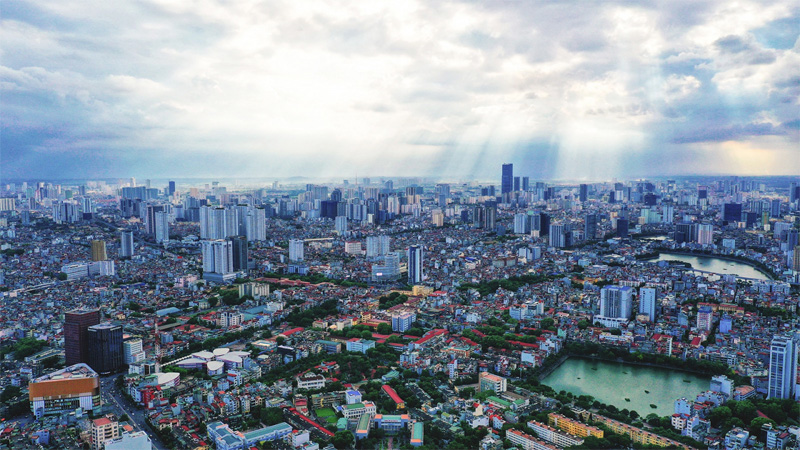
Along with economic growth and population increase, Vietnam has also experienced rapid urbanization in recent years. The emergence of dynamic, modern cities reflects the nation’s evolving landscape, contributing to the overall goal of comprehensive development. Beyond factors like area and population, the ranking of the largest cities in Vietnam is also assessed based on their holistic development in terms of economy, politics, culture, education and infrastructure.
TOP 10 LARGEST CITIES IN VIETNAM
| No | City name | Area (km2) | Population (people) | Population density (people/km2) |
| 1 | Ha Noi City | 3.359,82 | 8.435.700 | 2.511 |
| 2 | Ho Chi Minh City | 2.095,39 | 9.389.700 | 4.481 |
| 3 | Hai Phong City | 1.526,52 | 2.088.000 | 1.368 |
| 4 | Can Tho City | 1.440 | 1.252.348 | 870 |
| 5 | Da Nang City | 1.284,73 | 1.233.400 | 960 |
| 6 | Bien Hoa City | 263,62 | 1.272.235 | 4.826 |
| 7 | Hai Duong City | 1.668,28 | 1.946.800 | 1.167 |
| 8 | Hue City | 265,99 | 652.572 | 2.453 |
| 9 | Thuan An City | 83,71 | 618.984 | 7.394 |
| 10 | Thu Duc City | 211,56 | 1.207.795 | 5.724 |
Table of Contents
1. Hanoi city
Hanoi is the capital of the Socialist Republic of Vietnam, with a rich history spanning over 1,000 years. It is also recognized as a centrally governed city and classified as a special-grade urban area (alongside Ho Chi Minh City). Hanoi has long been referred to as the ‘Heart of Vietnam’ due to its vital role in the nation’s politics, economy, culture and society.
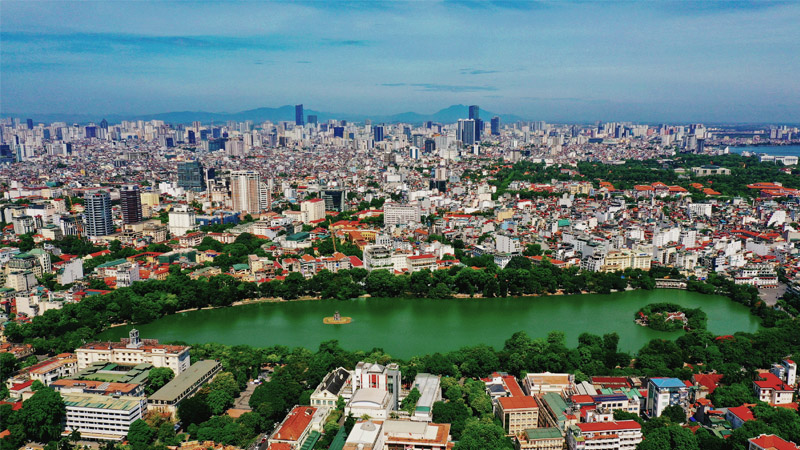
Hanoi city is located in the Red River Delta, geographically adjacent to the following provinces and cities:
- The East borders the provinces of Bac Giang, Bac Ninh and Hung Yen.
- The West borders Hoa Binh and Phu Tho provinces.
- The South borders Ha Nam and Hoa Binh provinces.
- The North borders Thai Nguyen and Vinh Phuc provinces.
With an area of 3,359.82 km², Hanoi is currently the largest city in Vietnam by size. It is also the second most populous city in the country, with approximately 8,435,700 residents.
Throughout its historical ups and downs, the ‘Thousand-Year-Old Capital’ of Hanoi has preserved its traditional cultural values along with numerous historical and cultural relics. This creates a strong appeal for tourism in Hanoi, attracting millions of visitors both domestically and internationally to explore and discover. Key destinations that define the cultural essence of the capital include: the Imperial Citadel of Thang Long, Ho Chi Minh Mausoleum, Temple of Literature – Quoc Tu Giam, Hoan Kiem Lake, One Pillar Pagoda and the 36 Streets of Hanoi,…
2. Ho Chi Minh City
Ho Chi Minh City, also known as Saigon, is one of the largest cities in Vietnam. Alongside Hanoi, it is classified as a centrally governed city and is recognized as a special-grade urban area in the country. Often referred to as the ‘Pearl of the Orient,’ Ho Chi Minh City is renowned for its vibrancy, bustling atmosphere, modernity, making it one of the most dynamic cities in the region.
Located in the Southeast region of Vietnam, Ho Chi Minh City shares geographical borders with several provinces and cities:
- The East borders Dong Nai province and Ba Ria – Vung Tau.
- The West borders Long An and Tay Ninh provinces.
- The South borders Tien Giang province and the East Sea.
- The North borders Binh Duong province.
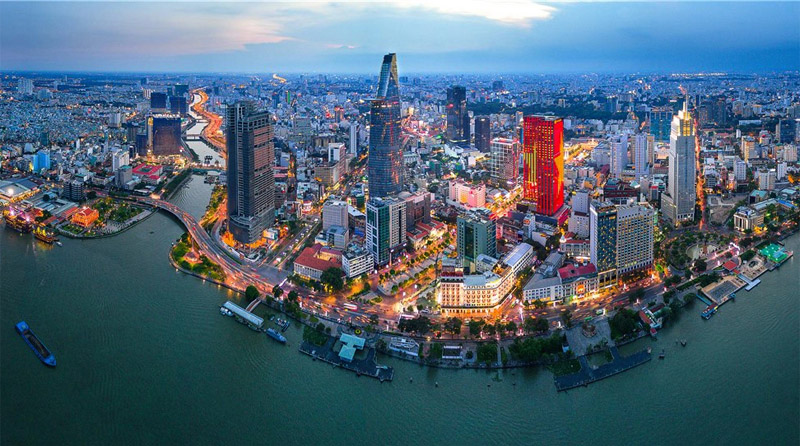
With a total area of 2,095 km² and a population of 9,389,700, Ho Chi Minh City is currently the second-largest city in Vietnam by area (only after Hanoi) and has the highest population in the country. Additionally, this vibrant city serves as the economic engine of the nation and is a key center for politics, culture and education. The economy of Ho Chi Minh City thrives across various sectors, including agriculture, aquaculture, manufacturing, mining, construction, finance and tourism. This economic dynamism attracts a large number of residents to live and work in the city.
In addition to its economic leadership, Saigon is also a renowned tourist destination known to many visitors. This region embodies a fusion of tradition and modernity, offering tourists a unique and diverse exploration experience. Some iconic landmarks of Saigon include Ben Thanh Market, the Independence Palace, Notre-Dame Cathedral Basilica of Saigon, the Ho Chi Minh City Museum, the Chinatown area and the Saigon Opera House,…
3. Hai Phong city
The next name on the list of major cities in Vietnam is Hai Phong, also known as the ‘City of Red Flamboyant Flowers’ or the ‘Port City.’ It is the largest seaport in the northern region and one of the five centrally governed cities in Vietnam, classified as a first-tier urban area. Currently, Hai Phong is recognized as a significant center for economics, culture, education, healthcare and science in the northeastern coastal region.
The geographical location of Hai Phong on the map is as follows:
- The East borders the Gulf of Tonkin in the East Sea.
- The West borders Hai Duong province.
- The South borders Thai Binh province.
- The North borders Quang Ninh province.
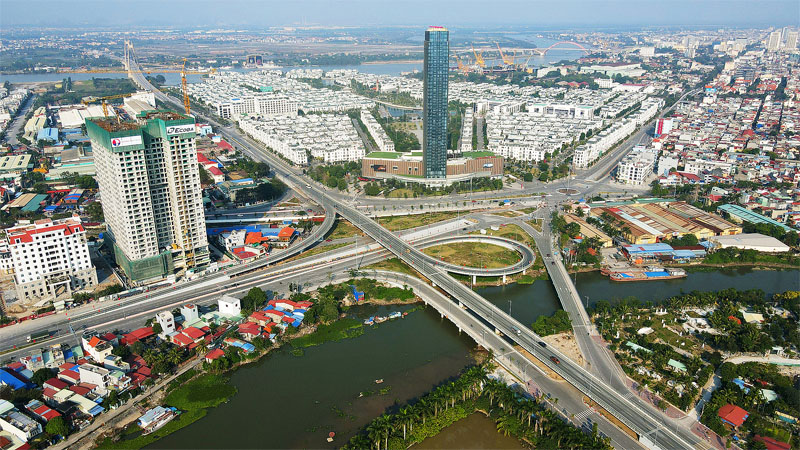
Hai Phong is the second-largest city in the northern region (after Hanoi) and serves as a national central city alongside Da Nang and Can Tho. It is renowned as an industrial port city, benefiting from deep-water ports that are highly advantageous for the development of the maritime transport sector. Furthermore, Hai Phong is home to numerous industrial parks, commercial centers and large service hubs in the region.
In addition to this, Hai Phong possesses significant potential for the diverse development of various types of tourism. The ‘City of Red Flamboyant Flowers’ boasts many historical and cultural relics, unique architectural works and beautiful beaches. If you have the opportunity to visit Hai Phong, be sure not to miss the following attractions: Cat Ba Archipelago, Do Son Tourist Area, Hon Dau, Red Pagoda, Nghe Temple and Voi Mountain,…
4. Can Tho City
Can Tho is a centrally governed city in Vietnam, classified as a first-tier urban area. It is also one of the largest cities in the country, experiencing rapid and remarkable economic development. Currently, Can Tho serves as an economic hub and a vital trading center for provinces in the Mekong Delta region.

Can Tho City is situated on the right bank of the Hau River, at the center of the Mekong Delta. Its geographical location on the map is as follows:
- To the East, it borders Dong Thap and Vinh Long provinces.
- To the West, it borders Kien Giang Province.
- To the South, it borders Hau Giang Province.
- To the North, it borders An Giang Province.
Can Tho is often referred to as the ‘city of rivers’ due to its intricate network of rivers, canals and waterways. The sedimentation from the major river branches has resulted in vast rice fields and lush fruit orchards, creating favorable conditions for the development of agriculture, livestock and aquaculture. Additionally, the city is gradually shifting its economic structure towards industry, construction and services.
Each year, Can Tho welcomes millions of visitors from both domestic and international markets. The distinctive tourism offerings in Can Tho include river and garden tourism, as well as experiential tourism linked to agriculture and local life. Among these, the floating markets and the system of islets represent the most culturally significant values.
5. Da Nang City
To answer the question ‘Which city currently has the largest area in Vietnam?’, Da Nang ranks among the top 10 with an area of 1,284.73 km². This centrally governed city is classified as a first-tier urban area in Vietnam. After more than 25 years of establishment and development, Da Nang is recognized as a hub for the Central Key Economic Region, contributing significantly to the comprehensive development of the nation through various phases.

Da Nang City, located in the South Central Coast region, holds a strategic position in terms of economy, society, security and national defense. Its geographical location borders the following provinces:
- To the East, it faces the East Sea.
- To the North and Northwest, it borders Thua Thien-Hue Province.
- To the South and Southwest, it borders Quang Nam Province.
Currently, Da Nang is regarded as the most livable city in Vietnam, boasting diverse natural landscapes and numerous beautiful beaches. Additionally, advancements in infrastructure and material conditions have facilitated stable economic growth and improved the quality of life for its residents. In recent years, a series of high-rise buildings, office spaces, modern shopping centers have been constructed, significantly accelerating the urbanization process of the city.
Moreover, Da Nang is well-known as a coastal tourist city, famous for many interesting destinations such as Ba Na Hills, the Lady Buddha statue at Linh Ung Pagoda, Dragon Bridge, Bang Beach, Marble Mountains, Mo Stream,…
6. Bien Hoa City
Bien Hoa City serves as the provincial capital of Dong Nai Province and is located approximately 30 kilometers to the east of downtown Ho Chi Minh City. It is recognized as a crucial transportation hub within the Southern Key Economic Region and has the following geographical borders with neighboring provinces:
- To the East, it borders Trang Bom District (Dong Nai Province).
- To the West, it borders Thu Duc City (Ho Chi Minh City) and Di An City (Binh Duong Province).
- To the South, it borders Long Thanh District (Dong Nai Province).
- To the North, it borders Vinh Cuu District (Dong Nai Province) and Tan Uyen City (Binh Duong Province).
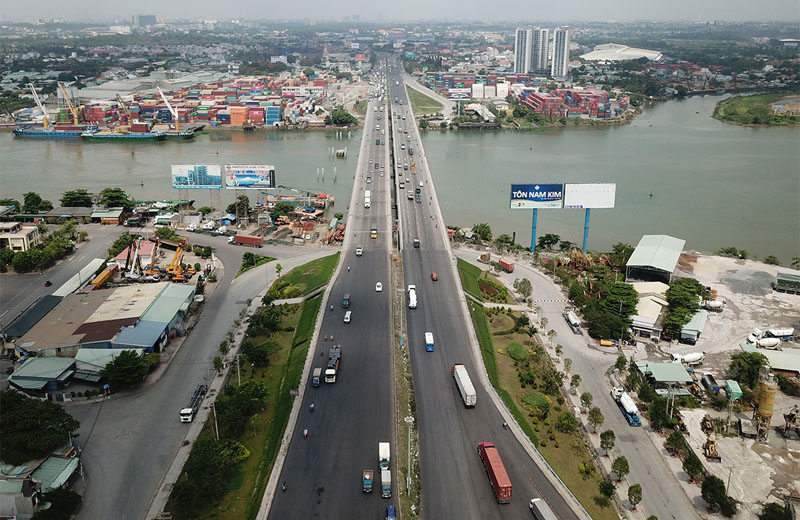
Bien Hoa City is also recognized as one of the foremost industrial centers in the country. It hosts several major industrial parks that lead the way in the industrial sector in Vietnam, such as Bien Hoa I Industrial Park, Long Binh – Dong Nai Industrial Park, Tam Phuoc Industrial Park and Ho Nai Industrial Park. These factors contribute to Bien Hoa’s inclusion among the largest cities in Vietnam today.
With a rich history spanning over 300 years, Bien Hoa City serves as a crossroads of various cultures. The city boasts numerous historical, cultural and architectural landmarks, including Tran Bien Temple of Literature, Buu Long Ancient Pagoda, Bien Hoa Cathedral, Mango Garden Tourist Area,…
7. Hai Duong City
Hai Duong is a Type 1 urban center under Hai Duong Province, located in the Red River Delta region. Positioned within the economic triangle of Hanoi – Hai Phong – Quang Ninh, Hai Duong City currently serves as a center for economics, education, science, technology, healthcare and services in the area. The geographical location of the city on the map is as follows:
- To the East: bordering Thanh Ha District and Kim Thanh District.
- To the West: bordering Cam Giang District.
- To the South: bordering Gia Loc District and Tu Ky District.
- To the North: bordering Nam Sach District.

Hai Duong is regarded as one of the largest cities in Vietnam, with an economic growth rate consistently ranging from 14% to 18% per year. The city has seen significant development across various sectors, including industry, agriculture, commerce and services. Additionally, its diverse natural landscapes and unique historical and cultural sites have contributed to making tourism a vital economic sector in the region.
8. Hue city
Historically recognized as the imperial capital of Vietnam during the Tay Son and Nguyen dynasties, Hue City is now one of the largest urban areas in the country. It serves as a cultural, tourism, education, science and technology center for the Central and Central Highlands regions. Hue City is located in the lower reaches of the Perfume River, near the Truong Son mountain range, is bordered by:
- The East Sea to the east.
- Huong Tra Town to the west.
- Huong Thuy Town to the south.
- Quang Dien District and the East Sea to the north.
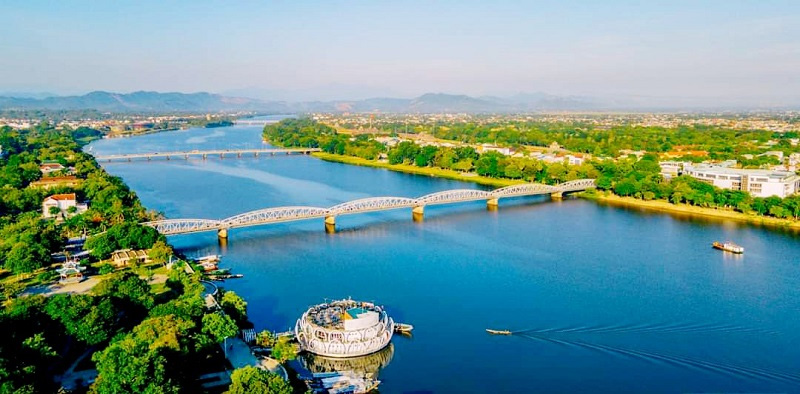
Located in the center of the country, Hue city possesses an important strategic position, helping to connect trade between the North and South. The city also has many large commercial centers and a number of high-end urban areas, contributing to accelerating the urbanization process. At the same time, the tourism industry in Hue continues to be focused on developing with a series of discovery destinations such as: Hue Citadel, Hue National Academy, Truong Tien Bridge, Dong Ba Market, Vong Canh Hill, Tu Duc Tomb ,…
With unique cultural and historical values, Hue is a destination not to be missed when you explore Vietnam. This city not only attracts tourists by its ancient and peaceful beauty but also by its unique cultural and culinary experiences.
9. Thuan An city
Thuan An city belongs to Binh Duong province, located between Ho Chi Minh City and Thu Dau Mot city. Geographic location on contiguous map:
- The East borders Di An city.
- The West borders District 12 and Hoc Mon district, Cu Chi district (Ho Chi Minh City) across the Saigon River.
- The South borders Thu Duc city (Ho Chi Minh City).
- The North borders Thu Dau Mot city and Tan Uyen city.
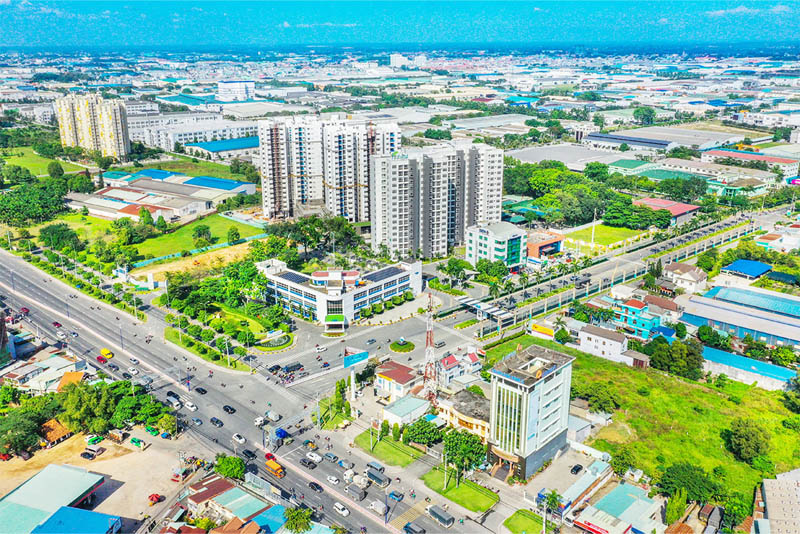
Thuan An City is an industrial hub, home to several of the country’s leading industrial zones, including VSIP 1 Industrial Park, Viet Huong Industrial Park and Dong An Industrial Park. The city has achieved a high economic growth rate, with an average income per capita ranking among the top in the country (approximately 144 million VND per year).
Aiming to become a center for urban services in the Southeast region, the city is actively enhancing the service sector within its economic structure. Additionally, efforts are underway to improve technical infrastructure, social infrastructure and facilities to capitalize on the city’s potential location. Currently, Thuan An City is classified as a Type 2 urban area and is intensifying investment resources to meet the criteria for upgrading to a Type 1 urban area.
10. Thu Duc City
Thu Duc City was officially established at the end of 2020 according to Resolution 1111/NQ-UBTVQH14, based on the merger of three former districts of Ho Chi Minh City: District 2, District 9 and Thu Duc District. As of January 1, 2021, Thu Duc became the first city in Vietnam classified as a city under a centrally governed city.
Located in the eastern part of Ho Chi Minh City, Thu Duc City is geographically situated as follows:
- To the East, it borders Bien Hoa City and Long Thanh District (Dong Nai Province), with the Dong Nai River serving as the boundary.
- To the West, it borders District 12, Binh Thanh District, District 1, District 4 (with the Saigon River as the boundary).
- To the South, it borders Nhon Trach District, Dong Nai Province (across the Dong Nai River) and District 7 (across the Saigon River).
- To the North, it borders Thuan An City and Di An City (Binh Duong Province).
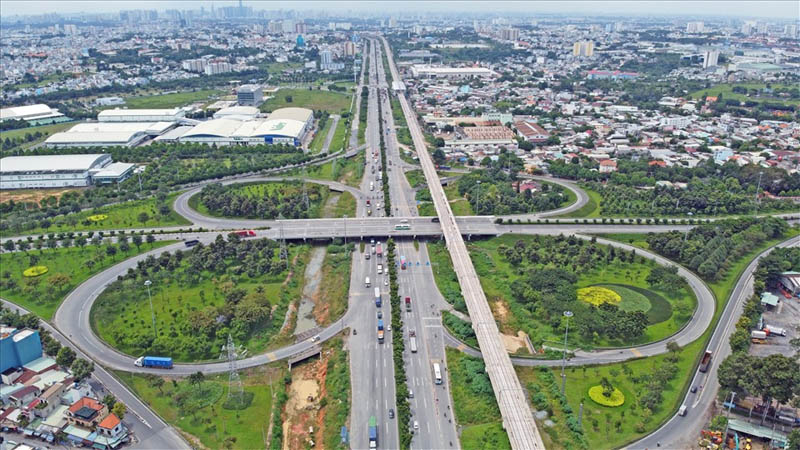
Located at the eastern gateway of Ho Chi Minh City, Thu Duc City currently holds a key role within the Southern Key Economic Zone. It also serves as a major transportation hub, connecting Ho Chi Minh City with provinces across the Southeast region. Currently, Ho Chi Minh City’s authorities are focusing on developing Thu Duc into a high-interaction innovative urban area. This region is seen as having great potential for the development of urban infrastructure, service infrastructure and especially the logistics sector for goods transportation.
As Vietnam continues its steady growth, major cities are becoming more modern and dynamic. Each city carries its own unique characteristics, from history and culture to natural landscapes. We hope that this updated list of the 10 largest cities in Vietnam for 2025 provides you with valuable insights and enhances your experiences as you explore Vietnam’s thriving urban centers.




